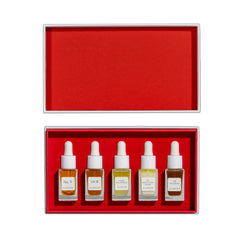A Formula Correction
When Serum Bioluminelle was first released it contained every ingredient that it has now, except for one: Hyaluronic acid.
Bioluminelle’s nascent formula included hyaluronic acid because I wanted to mimic the skin’s extracellular matrix components into a serum. The ECM contains many components needed for youthful skin. Among them are elastin protein, which is included in the Bioluminelle formula to this day, and the ECM also contains hyaluronic acid.
My original intent for using hyaluronic acid was to reinforce the skin’s ECM, hence contributing to anti-aging. However, what I was using hyaluronic acid for in Bioluminelle was not common usage for hyaluronic acid in skin care. Common usage for hyaluronic acid in skin care is for its supposed 'hydration capabilities".
Hyaluronic acid does not hydrate the skin. It dries it out.
I experienced hyaluronic acids drying action one afternoon in my lab when I was mixing a 1.5% concentration of hyaluronic acid into water. The mixture formed a substance that was reminiscent of hair gel in its thickness and consistency. The hyaluronic acid pulled all of the water from its environment to form a gel. I realized that if hyaluronic acid pulls water from a beaker, that means it’ll pull water from your skin. And when water is pulled from the skin that means skin dryness.

This is what 1.5-2% hyaluronic acid looks like.
And thats when I decided to pull all hyaluronic acid from OUMERE’s formulas.
The No. 9 reinforces the skin's ECM anyway, so it was never needed in the first place.
Natural hyaluronic acid vs. Hyaluronic acid in your skin care
There is a difference between natural hyaluronic acid and hyaluronic acid used cosmetically. When incorporated naturally into the skin’s ECM, hyaluronic acid’s function is controlled. It is not aggressively pulling water from its environment. On the other hand, when hyaluronic acid is put into a skin care formula, hyaluronic acid’s function is not biologically controlled. The result is hyaluronic acid forcefully pulling water from its surroundings the moment it touches your skin. The surroundings in this case is the water content of your skin. Hyaluronic acid is a thirsty molecule and every time it touches your skin it takes a big sip of water.
Creating True Skin Hydration
OUMERE never needed hyaluronic acid for ‘hydration’ because the OUMERE regimen creates a true path to skin hydration. The true path to skin hydration is not with skin care containing hyaluronic acid. Those products are clumsy in their formulation, haphazard in their functionality and devoid of biological principle. The true path to skin hydration is the following:
- Creating hyaluronic acid in the skin with daily chemical exfoliation
- Reducing inflammation and cellular damage with anti-inflammatory serums and use of sunscreen
- Delivering moisture with oil and water-based serums
- Locking in moisture with an oil-based serum
#4 is critical. Your skin’s hydration levels need to be protected otherwise all of the rest is worthless. Serum Bioluminelle contains water-based ingredients to deliver hydration into the skin and oil that sits atop the skin to lock in moisture.
An additional moisture lock that is effective, biologically inert (wont react with the skin), and locks in all moisture without a chance of escape is Vaseline. Vaseline, or petroleum jelly is something that I have found to be a top skin care ingredient for the following reasons:
- It does not react with the skin, meaning it won’t break skin cells down (unlike essential oils or fragrance which initiate the process of inflammation and cell death)
- Its molecular structure is massive so it will not go into your pores and cause clogging
- It has been purified so you are not exposing your skin to a contaminant, which is common with essential oils (and even plant oils and extracts when purchasing from a skin care company who is cheap with their ingredients)
There is also no credible scientific evidence that Petroleum jelly is harmful to the body. It can’t even be absorbed by the body. And in my experience the only people who voice their concern are those who are completely lacking in scientific education, training and experience. Which is why I always say to consider the source of your information.
In the evenings, after I apply my serums, my last step is to apply vaseline under and around my eyes, around the areas of the mouth that are prone to laugh lines, and the spots on the forehead that are the first to wrinkle. And in the morning those parts of my skin are always glowing and hydrated.
Note: People who shouldn’t use petroleum jelly are those with rosacea or inflammation because vaseline will trap heat in the skin. And if you have acne, be sure to not put vaseline over areas where you have (or are prone) to breakouts.
The Hydration Experiment
So here we have two ingredients, hyaluronic acid which is the trendy ingredient of the moment, and Petroleum jelly, the black sheep of the skin care industry. One everyone says creates hydration, but hasn’t been true of my observations. And the other, which I have observed to maintain skin hydration, despite the negative reputation.
Well, I tested both of them out and one was a clear skin care winner, and the other a skin care loser.
I made hyaluronic acid serums of ranging concentration and applied them to skin after the application of a control serum (no hyaluronic acid) and measure the skin’s hydration levels.
I then did the same experiment by applying vaseline to skin after the application of the control serum and also measured the skin’s hydration level.
One caused significant dryness to the skin while the other plumped the skin and showed significant hydration. Which one do you think it was?
Stay tuned for the next post where I share the results.


